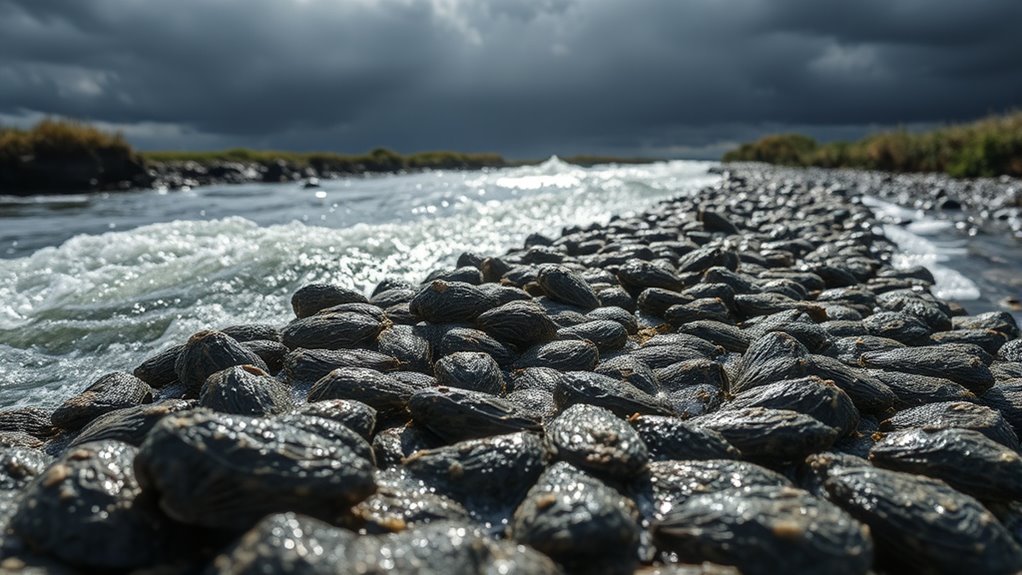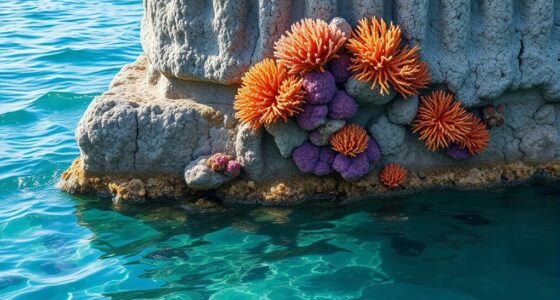Living breakwaters use oyster reefs as natural storm shields, dissipating wave energy to protect coastlines from erosion and flooding. These reefs absorb storm surges and reduce wave height, helping to stabilize shoreline areas. They also support marine life, boosting biodiversity and ecological health. By combining habitat restoration with coastal defense, living breakwaters offer sustainable, cost-effective protection. To discover how these innovative structures work and their benefits, keep exploring this evolving approach to shoreline resilience.
Key Takeaways
- Living Breakwaters use submerged oyster reefs to dissipate wave energy and reduce storm surge impact along Staten Island’s shoreline.
- The reefs provide habitat for oysters and marine species, enhancing ecological resilience and biodiversity.
- Oyster reefs serve as natural storm shields, protecting low-lying communities from damage during storms like Superstorm Sandy.
- The project combines ecological restoration with coastal defense, creating a sustainable and multifunctional shoreline solution.
- Active oyster cultivation and habitat enhancement improve reef effectiveness and promote long-term shoreline stability.

Have you ever wondered how communities can protect their shores while restoring marine life? The Living Breakwaters project off Staten Island’s South Shore offers a compelling answer. It’s an innovative coastal green infrastructure initiative designed to shield vulnerable shoreline areas from storm damage while creating thriving habitats for marine species. Spanning 2,400 feet of near-shore, partially submerged breakwaters made from marine stone and ecologically enhanced concrete, the project embodies a dual purpose: reduce wave energy and promote biodiversity. Placed between 790 and 1,800 feet from land, these structures are strategically positioned to absorb storm waves, lessen erosion, and help restore the shoreline. Built in response to Superstorm Sandy, the project aims to mitigate future storm impacts while reversing decades of beach loss along Tottenville.
Living Breakwaters off Staten Island protect shores and restore marine habitats with innovative, eco-friendly submerged breakwaters.
As you consider how it works, think of the breakwaters as underwater shields crafted with precision. They’re rubble mound structures with a stone core, layered with bedding stones, marine mattresses, and outer armor units. These layers are engineered to dissipate wave energy effectively, protecting the shoreline from destructive storm surges. The design includes “reef ridges” and “reef streets,” features that boost habitat complexity for oysters and other marine species. Hydrodynamic modeling guided the placement and shape of the structures, ensuring they provide maximum wave energy dissipation while fostering ecological growth. Special construction equipment, such as large cranes and amphibious excavators, was necessary to build these submerged structures. The project’s lead designer, SCAPE Landscape Architecture, partnered with engineering firms to develop a structure that balances storm protection with ecological benefits.
One of the project’s core ecological goals is to create and restore oyster reefs. Oysters are installed using methods like spat-on-shell and oyster shell gabions, which encourage larval settlement and reef development. These reefs serve as habitats for finfish, shellfish, and other marine life, boosting biodiversity and ecological resilience in Raritan Bay. The enhanced concrete units are designed with surfaces that maximize larval attachment and habitat complexity, further supporting marine productivity. The Billion Oyster Project leads active restoration efforts, including cultivating oysters off-site, collecting shells, and engaging the public through educational programs. As a result, the breakwaters do more than just protect—they also serve as vital ecological hubs. Incorporating the cost of coastal infrastructure, such as materials and construction, is essential for planning and funding similar projects in other communities.
The primary function of these structures is to reduce coastal risk by dissipating wave energy before it reaches the shoreline. This helps slow, and over time reverse, the erosion that has plagued the area for decades. A one-time sand replenishment along certain sections further stabilizes the coast. The structures are carefully sited to defend especially low-lying communities that suffered severe damage during Superstorm Sandy. By combining storm protection with habitat restoration, Living Breakwaters stands as a model for sustainable coastal resilience. It’s a smart, multifunctional approach that safeguards communities today and ensures healthier marine ecosystems for tomorrow.
Frequently Asked Questions
How Long Do Oyster Reefs Typically Last Before Needing Repairs?
You might wonder how long oyster reefs last before repairs are needed. Their lifespan varies, but generally, they can endure for decades if left undisturbed. Physical damage from storms, human activities, or environmental stress can shorten that time. Regular monitoring helps you identify when repairs are necessary, often within a few years, especially in exposed areas or with ongoing stressors. Proper site selection and maintenance can extend their durability.
Are Living Breakwaters Effective Against All Types of Storms?
Think of storm protection like a sturdy shield—living breakwaters are strong, but not invincible. You’ll find they’re quite effective against moderate storms, calming waters and reducing surge. However, during the fiercest hurricanes or big wave events, they might struggle, like a shield with cracks. To truly defend your coast, consider combining oyster reefs with engineered solutions, ensuring resilience against all storm types, big or small.
What Is the Cost Comparison Between Traditional Seawalls and Oyster Reefs?
You’re asking how traditional seawalls compare in cost to oyster reefs. Seawalls typically cost between $10 million and $20 million per kilometer, making them highly expensive upfront. In contrast, oyster reefs are much cheaper, averaging around $2,260 per hectare, especially if recycled shells are used. While seawalls require ongoing maintenance costing up to $1,791 annually, oyster reefs naturally regenerate, offering long-term ecological and economic benefits with lower costs.
How Do Oyster Reefs Impact Local Fisheries and Marine Life?
Imagine a bustling underwater city, teeming with life and opportunity. You’ll find oyster reefs acting as thriving nurseries and bustling marketplaces for marine species like blue crabs and flounder. These reefs boost fish populations, support local fisheries, and enhance biodiversity. By restoring them, you’re planting seeds for healthier ecosystems, better catches, and stronger coastal communities—transforming underwater habitats into vibrant hubs of life and economic significance.
Can Oyster Reefs Be Expanded to Protect Larger Areas?
You can expand oyster reefs to protect larger areas by carefully planning their size, placement, and orientation, which influence their effectiveness against waves and erosion. You’ll need to monitor their performance during storms and address threats like sedimentation or biofouling. By integrating reefs with other shoreline measures and promoting self-sustaining oyster populations, you’ll create scalable, eco-friendly barriers that adapt to rising sea levels and enhance overall coastal resilience.
Conclusion
By embracing oyster reefs as living breakwaters, you harness nature’s resilience to shield your community from storms. These vibrant barriers do more than protect—they restore, rebalance, and breathe new life into coastal areas. Imagine the rhythm of waves softened by these living shields, a steady drumbeat of hope and renewal. As you witness their power, remember: nature’s strength isn’t just in what it can withstand, but in what it can come back from—stronger, wiser, alive.










